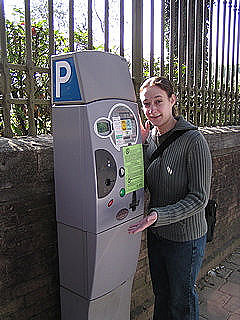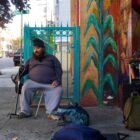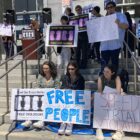 |
| Next-generation parking meters could allow a few machines to cover multiple parking spaces. Photo by wise via Flickr. |
San Francisco could be one step closer to getting parking meters in the park.
A committee of the Board of Supervisors Wednesday endorsed key legislation needed to make that possible.
If approved by the full board, the Municipal Transportation Agency would be granted jurisdiction over the parks, and could roll out a plan to install parking fee machines to convert more than 1,800 parking spaces in the eastern portion of Golden Gate Park to metered spaces by April 2010.
Currently, the MTA, which oversees parking, does not have jurisdiction in parks. That now falls to the Recreation and Park Department.
Clustered around the main attractions on the eastern side of the park — such as the de Young Museum, the California Academy of Sciences and the Botanical Gardens — the metered spaces could generate as much as $1.4 million for the parks department in the fiscal year 2010-11.
Fees would be collected through 133 parking machines. Additional profits for the MTA, from citations for failing to comply with meter rules, are estimated at $379,000 a year.
Noting that similar proposals have been discussed and discarded over the last seven years by several mayors and boards, parks commissioner Jim Lazarus insisted that the addition of metered parking is "good public policy in line with our transit-first policy."
The plan stuck this time around, when budget committee chair John Avalos convinced Mayor Gavin Newsom last Wednesday — during the marathon budget negotiations that produced the framework budget for the coming fiscal year — that the installation of the meters was aligned with the city’s environmental priorities.
Parks director of finance Katherine Petrucione also spoke to the committee, addressing concerns that the introduction of parking fees could discourage use of the park.
The pricing is "infinitely programmable" and should be able "to address some of the concerns to differentiate between people going for a run and people going to the institutions all day," Petrucione said. "We want to be rational."
The parking meter zone would extend from the eastern edge of Golden Gate Park to Crossover Boulevard, which carries traffic on Highway 1 through the park just west of Stow Lake from 19th Avenue to 25th Avenue.
Because the of the size of the affected area, it is likely that rates will vary with distance to popular attractions.
"The park is not an island unto itself," Petrucione said, adding that the department would seek to establish rates "similar to those immediate adjacent to the park" such as the commercial district at Ninth and Irving streets, to prevent the park from being a more attractive option for drivers who are going to businesses outside of the park.
Currently, people driving to the University of California-San Francisco medical campus and other non-park destinations use the free parking in the park as overflow, but the pricing system under consideration by the MTA and the parks department seeks to eliminate this kind of behavior. Lazarus said the parks department wants to discourage people from using the park as a cheap option for adjacent areas.
One suggestion for a fee-scale would charge relatively little to park for a few hours but place a heavy penalty on all-day parking. This would help distinguish between drivers who are going for a run or visiting the museums and those commuting to nearby neighborhoods.
"We would be able to charge more for all-day parking," and discourage longer term parking within the park, Lazarus said. "This can free up needed parking for the Academy of Sciences" and other institutions. That would mean the city "can turn over revenue for park users."
Petrucione noted that the goal was to encourage people to get out of their cars and instead walk, bike or take public transportation. By augmenting the shuttle system, people could also park farther away, in the western section of the park, and still reach destinations on the eastern side quickly.
The change would involve checks and balances between the two city agencies when coordinating metered parking in the parks. The MTA would set the meter rates and the parks department would determine where and how many spaces and collection machines would be installed.
Avalos pointed to safeguards written into the language of the legislation, which adds some authority for the Board of Supervisors. "Meters would not be placed in parks without our authority," he said.
Two kinds of machines could be used. Pay-and-display machines require drivers to show a receipt inside the car. With numbered spaces machines, a driver indicates the identification number of the car’s spot.
After the vote, supervisors David Campos and John Avalos broke into chatter about how they recently voted to increase Muni transit fees.
"If we’re willing to ask Muni riders to pay more, then it’s a matter of fairness to ask drivers to pay more," Campos said.
Having just purchased his Muni FastPass the previous day, Avalos added that the parking fees are needed "to share the pain."
The proposal will go before the full board on Tuesday.









